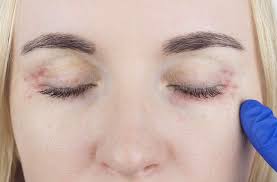What is ocular rosacea? Symptoms and causes of ocular rosacea
Ocular rosacea: What you need to know
If your eyes are red, itchy, swollen, or you frequently develop styes, don’t ignore it. While these symptoms can be the result of environmental allergies or a simple blocked tear duct, they can also be a sign of a chronic condition called ocular rosacea.
What is ocular rosacea?
Ocular rosacea is a subtype of rosacea that causes inflammation and burning in the eyes and eyelids. Rosacea is a chronic skin disease that primarily affects women between the ages of 30 and 50.1. Up to 58% of people with rosacea have concomitant eye problems, with men and women affected equally. However, 20% of cases of ocular rosacea have no skin symptoms prior to diagnosis. 2,3 This means that you can have ocular rosacea even if you don’t have symptoms of rosacea.
Symptoms and causes of ocular rosacea
Symptoms of ocular rosacea can affect any part of the eye, including the eyelids. You may notice one or more of the following symptoms frequently.
Red, itchy, burning, or watery eyes
Grainy feeling or feeling as if something has entered your eye
Dry eyes
Sensitivity to light
Eyelid inflammation (blepharitis)
Visible thin veins in the eyelids near the eyelashes
Recurrent eyelid infections, such as styes or hailstones
Inflammation of the cornea, which may cause blurred vision or vision loss
The cause of ocular rosacea is unknown, but it may be related to one or more of the following:
Genetics: If one or both of your parents have rosacea, you are also at a higher risk of developing rosacea
Bacterial infection: Helicobacter pylori, which usually affects the intestines, can also cause eye inflammation.
Blocked eyelid glands: A condition called meibomian gland dysfunction means that your eyelid glands don’t produce enough oil to prevent your eyes from drying out.
Eyelash mites: While everyone has eyelash mites, people with rosacea tend to have more of them than normal, which can cause inflammation.
How is ocular rosacea diagnosed?
There is no specific test to diagnose ocular rosacea. Instead, your doctor will determine the cause of your symptoms based on your medical history and observations from an eye exam.
Ocular rosacea is diagnosed when you have at least two symptoms, including rosacea skin symptoms.
Ocular rosacea is classified into three grades:
Grade 1: Mild itching, burning, sandy sensation in eyes
Grade 2: Burning, stinging, or crusting in eyes and eyelids
Grade 3: Pain, sensitivity to light, or blurred vision
How to Treat Ocular Rosacea
Treatment of ocular rosacea depends on the severity of the condition. Treatment can relieve symptoms, but there is no cure for this chronic condition. It is important to treat your symptoms because, if left untreated, ocular rosacea may lead to permanent vision loss. It is always recommended to see a specialist to get a proper diagnosis and treatment plan.
Initial treatment includes good eyelid hygiene.
Wash your eyelids twice a day with warm water or baby shampoo.
Use artificial tears to relieve dry eyes if necessary.
Avoid makeup if your eyes are sore. If you wear makeup, choose non-greasy or fragrance-free products.
Do not wear contact lenses if your eyes are irritated, especially if they are dry.
Avoid certain rosacea triggers, such as spicy foods or alcohol.
For more severe symptoms, your doctor may prescribe oral antibiotics, such as doxycycline, tetracycline, minocycline, azithromycin, or erythromycin, to treat infection and inflammation. They are usually given at lower doses for longer periods of time to treat inflammation.
Topical steroid medications may be prescribed when other antibiotics have failed to resolve inflammation, corneal damage, or chronic eye irritation. They are only used short-term, as long-term use of steroids may cause other eye problems, such as glaucoma or cataracts.
An alternative to treating inflammation with steroids is topical cyclosporine, an immunosuppressant that is particularly helpful for dry eyes. It is safer to use long-term than steroids.
Some studies have shown that omega-3 fatty acids can relieve dry eye symptoms.
Hail or styes that don’t respond to other treatments can be removed surgically.
Avoiding rosacea flare-ups with ocular rosacea
Ocular rosacea has the same triggers as rosacea. If you have both ocular rosacea and rosacea, the same conditions can cause red spots on your skin and eyes. Common triggers are:
Spicy foods
Alcohol
Sunlight, wind or extreme temperatures
Extreme emotions, especially stress, anger or embarrassment
Intense physical activity
Taking a hot bath or sauna
When to see a doctor
If you have burning, red or itchy eyes, see your GP. If he suspects you have ocular rosacea, he will refer you to your optician or ophthalmologist.
You should also see an ophthalmologist if your ocular rosacea symptoms get worse or flare-ups become more frequent. Tell them if you have any new symptoms or triggers.
Go to the emergency department if you experience pain, dizziness, vision loss, blurred vision or double vision.
Living with Ocular Rosacea
While there is no cure for ocular rosacea, regular treatment and good eye hygiene can control symptoms and prevent disease progression. Work with your doctor to determine a disease management routine that’s right for you.
DQH Can I use salicylic acid first and then vitamin C?
It’s easy to create a skincare routine, but knowing how to use it is another thing entirely. In most cases, if you’re not getting the desired skin results, it could be due to the layering of conflicting ingredients. So, is it possible that salicylic acid and vitamin C are such ingredients? Or are these active ingredients the duo that’s been missing from your skincare routine? If you want answers, stick around because today we are going to explain the benefits of salicylic acid and vitamin C and how they can be used in your daily life.
What are the benefits of salicylic acid for skin?
Salicylic acid is one of the most commonly used beta hydroxy acids and is favored by many people with oily, acne-prone skin. This acid is derived from willow bark, and unlike its water-soluble relatives (called alpha-hydroxy acids), salicylic acid is oil-soluble, which means it can penetrate deeper into the lower layers of the skin. Once it reaches the lower layers, it can help unclog pores of excess sebum, dirt, bacteria, debris, and impurities. This results in clearer skin tones and greater definition.
Not only does salicylic acid benefit the underlying layers, but the outer surface of the skin benefits as well. When applied to the skin, salicylic acid removes the buildup of dead skin cells. This is accomplished by breaking the bonds that hold dead cells to the surface. Over time, this can cause the complexion to look dull and prone to acne, blackheads, and other blemishes.
If you’d like to learn more about salicylic acid and how it can improve your skin, check out this dedicated blog post from a beauty insider.
What are the benefits of vitamin C for skin?
Vitamin C is considered one of the most powerful antioxidants, which means it is very effective at fighting free radicals and preventing them from causing further skin damage. Examples of free radicals include pollution, central heating, UV rays and harsh climate. They attack proteins, fats and cell membranes as soon as they come into contact with the skin, causing signs of premature aging such as fine lines and wrinkles as well as hyperpigmentation, flaky patches of skin and loss of elasticity.
Many people usually prefer to use vitamin C in their morning routine as this ingredient gives the complexion a radiant glow. You’ll also find that vitamin C can target areas of hyperpigmentation, plumping the skin and reducing the appearance of fine lines and wrinkles.
The thing about vitamin C is that there are a lot of outdated studies going back to the 1950s that describe vitamin C as an unstable skin component. Thanks to improvements in modern technology, this is no longer the case as all products now contain a stable form of vitamin C.
Visit The Beauty Insider to learn more about vitamin C. So please check out our blog post.
Can I use salicylic acid first and then vitamin C?
Yes, you absolutely can. In fact, it’s thought that using salicylic acid before using vitamin C ensures it penetrates faster and works faster.
This is an efficient way to utilize two power sources, and the reason has to do with pH. For example, the skin’s natural pH is about 4.7, making it slightly acidic. Salicylic acid and vitamin C are also both acidic, and you’ll find that vitamin C is absorbed quickly into the skin. Therefore, using salicylic acid beforehand can increase the acidity of the skin and allow vitamin C to penetrate into the skin faster.
While this is considered an effective way to combine two powerful ingredients, you need to be aware of your skin type and how it reacts to certain active ingredients. Even people with perfect, normal skin can experience skin sensitivity and irritation. Therefore, always consult a doctor or dermatologist before using any new products on your skin.
It’s also important to follow skin application rules. In this case, you need to use the product correctly to ensure you get the best results for your skin. If you’re not sure what I mean, the basic rule for skin is to start with the thinnest consistency and work your way up to the thickest consistency. This prevents a barrier from forming on the surface, preventing other active ingredients from penetrating the skin.
Can I use salicylic acid at night and vitamin C in the morning?
Yes, absolutely, this is considered the most effective way to get returns without any adverse side effects. This is because there is enough time between applications to ensure that the skin’s pH levels return to balance.
You’ll also find that Vitamin C is rich in antioxidants and is perfect for use in the morning to ensure your skin is protected and looking its healthiest. Due to the small size of salicylic acid molecules, it is an acid that is able to reach the deepest parts of the skin. While this is effective at keeping skin clear, it also increases the risk of irritation and photosensitivity. Therefore, many people prefer to use powerful BHAs in their evening routine without exposure to UV rays, pollution, or harsh weather.
Warning: If you avoid using sunscreen every day, none of these ingredients will do what your skin needs. The combination of chemical peels and powerful ingredients increases the risk of further damage to the skin’s surface. Use SPF 50 every day to keep your skin protected and your lipid barrier healthy, even on cloudy days, keeping your skin in top condition.



